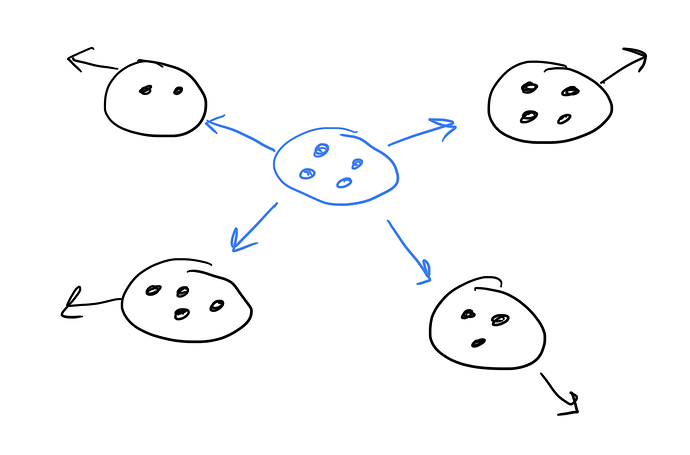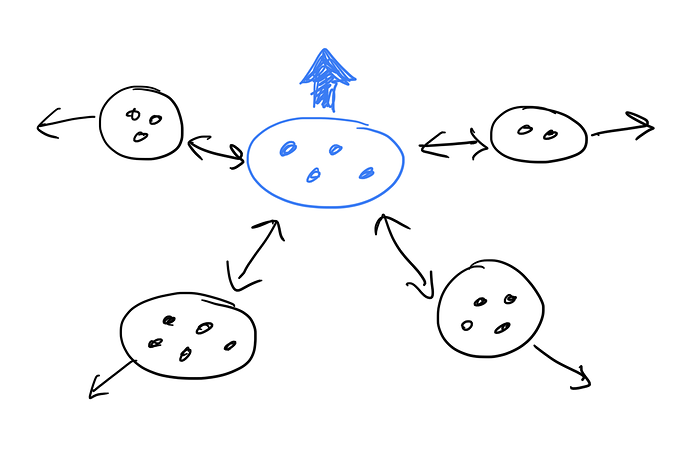Howdy all… following up on this post with an update about (1) Marketing Operating Principles and (2) Org Design
tl;dr
Marketing org will be set up as a team that has two responsibilities
- To enable/amplify work done by any Radicle core team or contributor through providing best-practice guides, training, access to brand channels so anyone can market their own work
- To autonomously create campaigns that drive awareness & adoption of Radicle based on their own roadmap & priorities
Operating Principles
Overview
Principles define how a team works and are the values that underpin everything that we do. In the Marketing context it’s important to note that they are not the same as Brand Principles which are more external (how you want the brand to be perceived) but are rather more internal (how the team works with others).
Principles will help us to hire the right people onto the team, guide how we approach marketing topics, and provide expectations to other people and teams as to what to expect from Marketing.
The Fundamental Principles
These principles guide how the team is structured and interacts with the rest of the org, community, and wider ecosystem.
1) Act autonomously
In a decentralised org with multiple different actors and multiple different products, Marketing needs to be clear to which goals it should be aligned so that incentives and actions are clear. This means, primary goals of the DAO will be the guiding factor and Marketing has the ownership & accountability to create the prioritisation that it thinks most supports those best. This will ultimately be validated by getting community buy-in.
Practical implications of this are that Marketing will be able to “borrow” things from across the org to turn them into big stories, prioritise work as it sees fit to serve the overall goal, and act with speed (foregiveness>permission, since permission is complex in decentralised org).
2) Enable & Amplify - Since any team can do marketing, we enable others
Anyone can “market” their contributions to Radicle using their own channels. To ensure maximum coherency to a master brand, Marketing will provide toolkits, education, brand-owned channels with reach, and guidance about how to do this best.
3) Collaboration by default
Marketing team should embrace the spirit of the Radicle (and broader web3) ecosystem and seek partnerships by default. Any initiative can be improved by joining forces with key people or organisations with shared goals, to drive better understanding and reach.
Working Principles
These principles guide how the team is structured and interacts with the rest of the org, community, and wider ecosystem.
1) Technical simplifiers
Radicle is a complex stack of products and our (first) users are also likely to be technical. Therefore, we are also technical marketers who understand the complexity of our protocol/product but we aim to simplify that into clear messaging to all potential audiences, no matter their familiarity with any of our concepts (OSS, web3, p2p, etc…).
One practical implication of this is that we should be mindful of who we’re communicating with - trying to minimise usage of acronyms or technical terminology unless sure that it’s a purely technical audience.
2) We are humble, not hype merchants
There’s a lot of hypesters and hucksters in the tech and blockchain worlds. We want to remain real, honest, and down-to-earth. We have a big vision and are ambitious about our impact but we want to be realistic and honest about what we have today and how things work. We conduct ourselves with humility and humour. We are more concerned with real people getting real value from the various Radicle products than boosting our egos or token price. Radicle is built on and by a community and should always have a human face when communicating with a wider audience.
3) Flexibility > Perfection
Much like our protocol, we orient around flexibility rather than structured hierarchies, approval processes, and rigid brand guidelines. This enables us to move faster, enable more people within the network. We are a team of individuals not a hierarchical unit. We focus on a fun brand, not a serious one.
Marketing Org Structure
Introduction
Before we leap into action, we need to define how the Marketing Team at Radicle will be organised, and how it will interact with itself and other teams. This document aims to present alternative models with a recommendation on how to proceed.
A quick note on definitions: when written without the capitalisation, marketing refers to the activity, whilst with the capital (Marketing) refers to the team/fuction.
Org Design Models
A large proportion of the marketing activity will be based on product or partnerships and thus the org design should be oriented towards such a scenario. Obviously, there will be other (particularly top of the funnel, awareness-driving) activities where interaction with product teams is less but this shouldn’t dictate the org model.
Given the decentralised nature of the Radicle org, there are a number of models the Marketing Team could utilise. When evaluating these models, we’ll want to ensure that they reflect the Principles (![]() ) as well as the following elements:
) as well as the following elements:
- Which fundamental competencies do we need and where/how should they be employed?
- Efficiency and utilisation of individual contributors
- How to enable teams (including a Marketing Team) to be maximally autonomous.
- What creates the greatest coherency for our target audiences (end users, investors, community members etc.)?
- How to manage the incentives for performance and measurements of success
Model 1: The Traditional Centralised Marketing Team
In a traditional company, everything flows through the centralised Marketing Team who have the ownership of (practically) all communication channels and, with the input of multiple teams from product, finance, sales etc…, will define the brand narrative, marketing campaigns, calendar and so on.
Pros
- Consistency of messaging through a controlled narrative
- Prioritisation of marketing campaigns and activities
- Centralised budgeting and planning
- Accountability
Cons
- Slower
- One team has a stranglehold on what is communicated
Recommendation
This model simply can’t work in a decentralised organisation. Even if it were desirable, there is no way to ensure all communications flow through one team without compromising the efficiency and autonomy of the overall organisation.
Model 2: Every team gets a Marketing person
A fully decentralised “squad” model where, much like engineers or designers, each team has a marketing person dedicated to the goals of that team, allowing for speed and specialisation.
Pros
- Fastest & most autonomous approach
- Dedicated resource gets to be an expert on each team
Cons
- While there may be some specialisation in marketing skills to specific projects, would probably need to be a multi-skilled marketing generalist in each team, rather than a collection of channel experts
- Dependent on roadmap, likely under-, or occasionally over-, utilisation of individual people (although somewhat mitigated with potential for part-time contributors)
- Harder to share skills and develop within a core group of marketers
- With potential diversity and spread of teams and contributors, this could get unpredictable and out of control
- Individual is a single point of failure (and can never, ever, ever take a holiday or be sick…
 )
)
Recommendation
Cons definitely outweigh the risks and it’s not a sensible place to start for Radicle. Having said that, this could be the long term vision for marketing in a few years time.
Model 3: Central Services Team
Acting as an agency that can be “hired” out to various teams as and when needed.
Pros
- Incentive structure can be setup to “value” the impact of the marketing team
- Marketing team can scale and grow in line with demand, if it proves impact
- Goals and ownership are clear, for each project Marketing serves a different team’s objectives
Cons
- Marketing doesn’t have much autonomy to identify their own goals unless hired by another team
- Potentially complicated and takes time to implement in the org
- Completely new model for Radicle
Recommendation
In theory, this model sounds great but defining and creating those internal incentive/payment structures feels like it might be overkill for Radicle at this stage.
Model 4: Fully Autonomous Team
An independent team with a push-and-pull interaction model towards other teams that has two goals: firstly, to enable teams to develop and maximise the effectiveness of their own comms channels as well as taking the best from across the network to own through brand-owned channels.
Pros
- Best of both worlds model
- Closest thing we can aim for when it comes to narrative consistency
- Enables Marketing team to own key external relationships (e.g. for running events, sponsorships etc.) without internal dependencies
Cons
- Could be spread thin across lots of different activities
- Potential for conflict if teams sense prioritisation isn’t right
- Requires marketing team members to be technical and entrepreneurial - navigating ambiguity
- Requires a lot of internal communication and collaboration to ensure smooth running
Conclusion
This seems like the most sensible place to start as it’s a mix of the other models and diving in here will help to calibrate what is needed moving forwards. In reality, there might be role specialisation within the marketing setup anyway, such that a product marketer, for example, is working a lot with the individual teams, while a comms or events person would be working more solo.
Summary
Models 3 & 4 are the most interesting and are quite similar in terms of the structure and resourcing of the marketing team itself. But the incentives and complexity to set them up clearly differ.
Thinking about the principle of flexibility and given the decentralised nature of the product, Model 4 is where I believe we should start with the focus on finding the right balance of push/pull between other teams.
Working with product teams/contributors
When working on new features/products, non-marketing teams may approach marketing in a number of ways.
First, Marketing team needs to create awareness for why marketing is important (e.g. to generate awareness/adoption) for teams that don’t have it top or mind, or those who think it’s not relevant. Here it’ll be important to create an ongoing sense of momentum, clarity of the marketing roadmap, and resources for people to learn more about the whys/hows and success stories.
Secondly, once demand for marketing is there, the question will be whether teams want to take this responsibility themselves or offload it to a Marketing function. Where it makes sense, enabling teams to run their own marketing with support from Marketing is the best setup - it brings authenticity to the work and builds scalable capabilities throughout the org.
To enable this, Marketing team will need to develop are core set of guides and toolkits for others to use. This serves two purposes - it lightens the load on non-marketers, whilst also providing some consistency to the end product. Additionally, Marketing will need to develop and manage a Channel Map with clarity about which ones are owned centrally (brand channels) vs. decentralised. If Marketing feels like there are missed opportunities, they should have the autonomy to take those and create campaigns around them, ideally with the team’s support in the background.
Finally, it’s important that, wherever possible and regardless of whether it’s being driven by Marketing or the team themselves, there’s time in advance to allow for alignment and creative campaign thinking on the go-to-market or release campaign strategy. For this reason, we’ll set up a Product Marketing Framework and prioritised release calendar.
Next steps
- Start hiring for first contributor roles within Marketing
- Outline the marketing calendar, channel map, and release planning process



